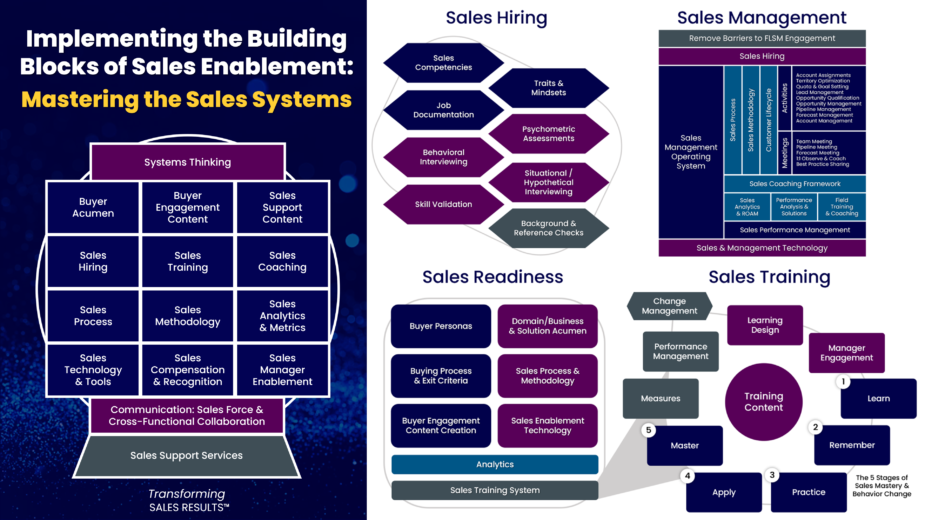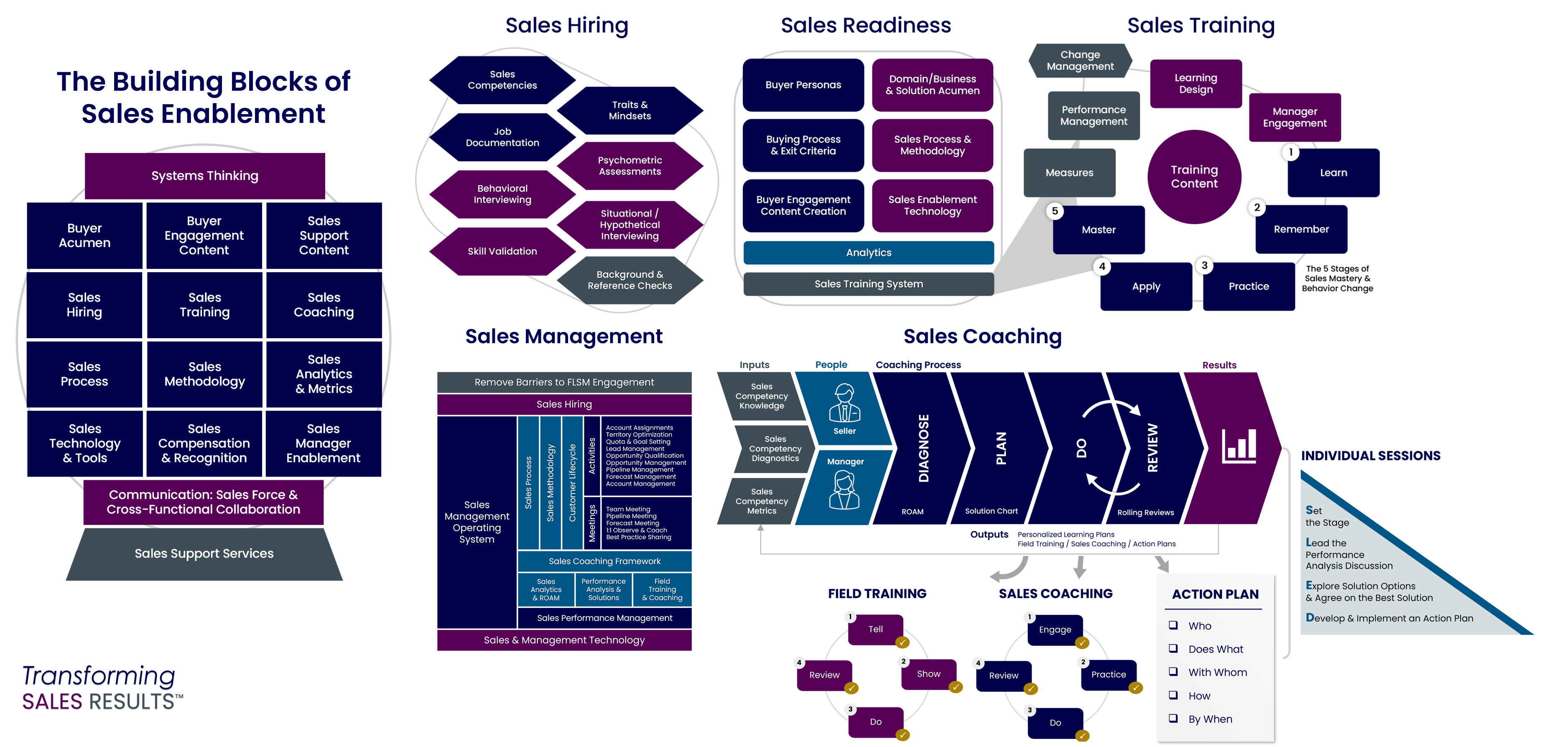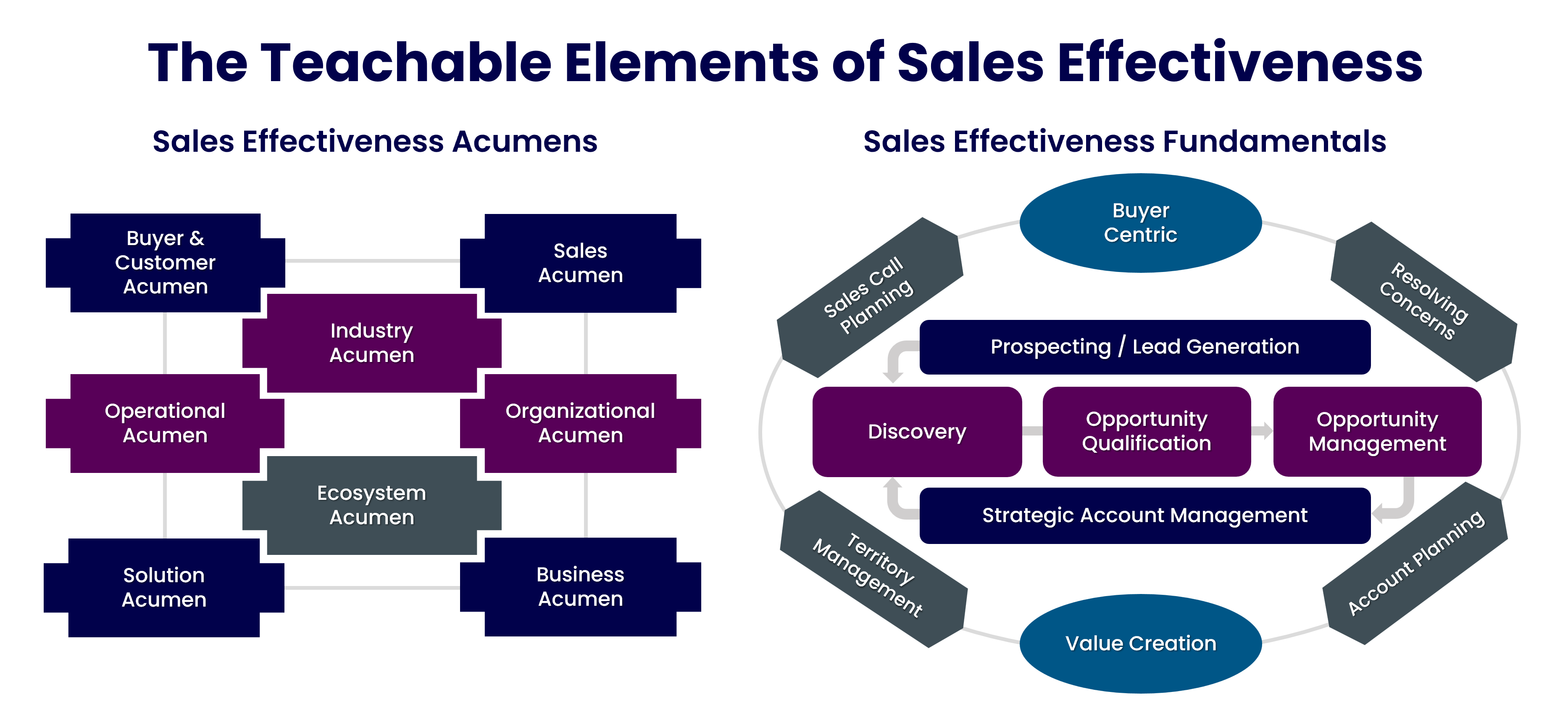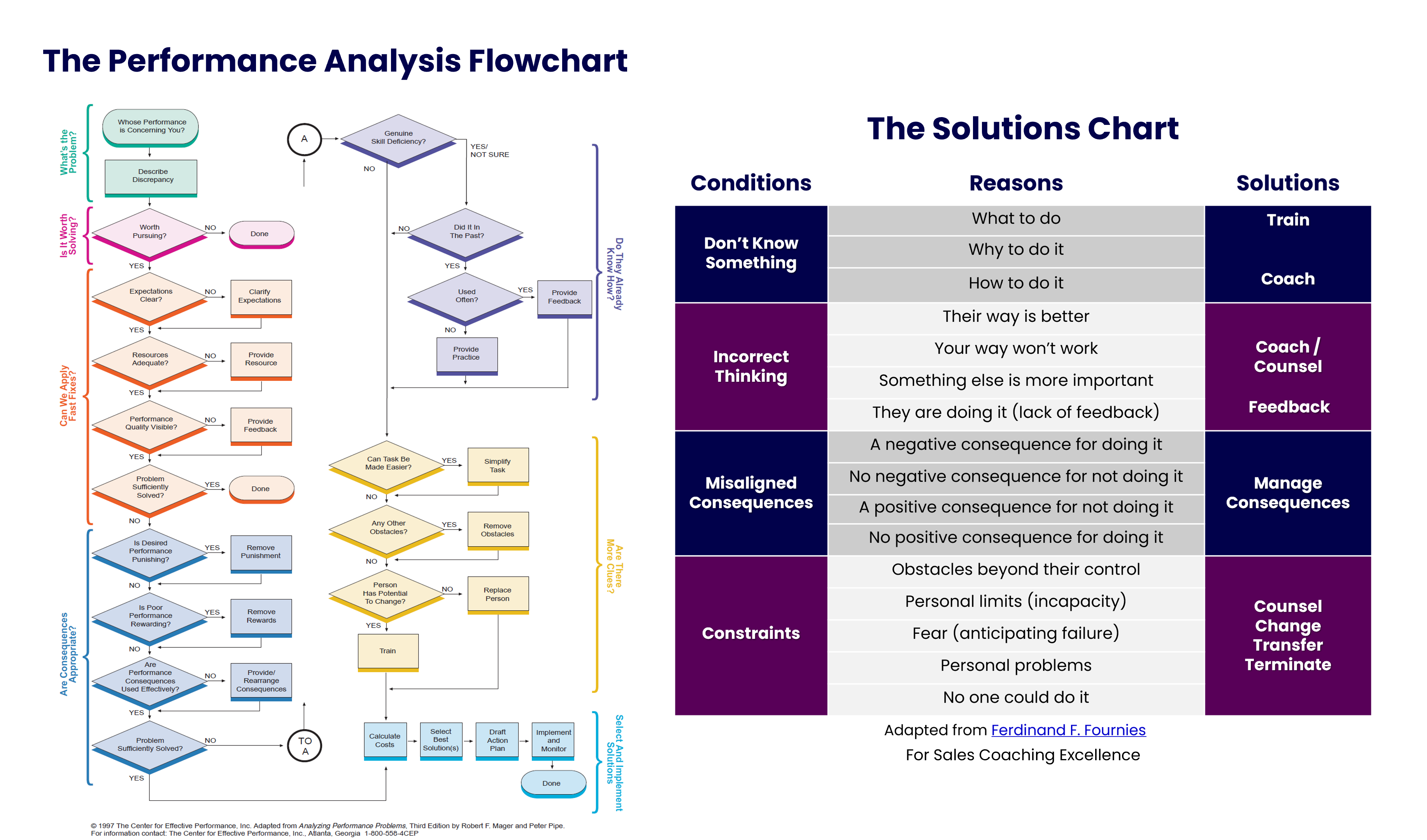Implementing the Building Blocks of Sales Enablement: Mastering the Sales Systems

[This post was originally published here, in my Sales Enablement Straight Talk newsletter]
Today, I want to delve into the nuances of the systems that support the Building Blocks of Sales Enablement framework. Many of you have asked about these systems – how they differ from the blocks (and support them), and how to maximize their effectiveness.
This is sometimes challenging to explain, because the examples I use might resonate with one person in one situation but not with another enabler in a different circumstance. I recognize that this is part of what makes sales performance improvement work complex and overwhelming for some. I wish I could change that, but I can’t. As I frequently say, in our role, we have to wade into the complex, deep, intricate details to make them easier for others. But someone has to do the hard, complex work – and in the world of sales performance improvement – that’s us.
With that preamble, let’s dig in.
Introduction
When implementing the Building Blocks of Sales Enablement, understanding the nuances of the various systems involved is crucial. These systems are interrelated, interconnected, and symbiotic, forming the backbone of a maximized go-to-market machine.
While there are many possible systems, the core systems I frequently work with include:
- The Sales Hiring System
- The Sales Readiness System
- The Sales Training System
- The Sales Management System
- The Sales Coaching System
Within these, the Sales Training System is embedded into the Sales Readiness System, and the 5 Stages of Sales Mastery and Behavior Change is embedded into the Sales Training System. Furthermore, the Sales Coaching System is a subset of the Sales Management System.
This is how systems thinking works. As mentioned above, they are interrelated, interconnected, and symbiotic. Implemented well, these systems enable repeatable, replicable, scalable, and predictable performance, acting as the implementation framework for the core building blocks.
However, there are nuances in their application that vary based on the specific context and needs of an organization. Let’s explore some of these nuances. As mentioned already, please remember that the nuances I mention are merely some examples and may or may not apply to your specific situation. Context reigns.
Sales Hiring System
In hiring, the approach may vary significantly between entry-level and senior roles. Entry-level positions might require a heavier focus on mindset, traits, and cultural fit, while senior roles might demand a more thorough evaluation of past performance, competencies, and strategic thinking abilities. The former may not include skill validation (role play), while the latter certainly should. The former may also include more hypothetical questions, while the latter would likely lean toward behavioral.
Similarly, the criteria for hiring in a startup versus an established company differ. A startup might prioritize agility and entrepreneurial spirit over experience, whereas an established company would look for individuals with a proven track record in specific sales processes and methodologies.
Role-specific criteria also play a part, as technical sales roles may require specific industry knowledge and technical skills assessments, whereas generalist roles might focus more on communication and relationship-building capabilities. Similarly, the skillsets for hunting or new business development would contrast with the need for territory and account management expertise.
When you just look at the system, it seems so clear-cut, doesn’t it? But these are examples of the nuances that you should consider in the real world. That said, once you determine the hiring approach in your context, perhaps with role differences, it’s very important to execute consistently, or at least by role. This is critical for fairness in the hiring process and will also help you avoid legal issues.
Sales Readiness System
From the two images above, you can see the Sales Readiness System and view how the Sales Training System is a subset of it.
Do you notice anything about the elements of this readiness system?
- Buyer Acumen is a building block.
- So are Buyer Engagement Content, Sales Process, Sales Methodology, Technology & Tools, and Sales Analytics & Metrics.
- The Acumens mentioned are part of the Sales Effectiveness Acumens that are foundational to going to market successfully.
This readiness system is about pulling all of these things together to “ready” or prepare and enable your sales force to go to market and execute the Sales Effectiveness Fundamentals.
In terms of context, market dynamics (and changes in Buyer Acumen) affect sales processes. In fast-paced industries, sales processes need to be agile and adaptable to rapidly changing market conditions. This might involve more frequent updates and training or sales support content to keep the sales force aligned with the latest strategies and tactics. Additionally, different customer segments may require tailored sales approaches. For example, selling to SMBs might involve a more straightforward transactional or consultative sales process, while enterprise sales could require a more strategic, multi-threaded approach.
These are just a few examples. As you think through this system and look at all the elements, you’ll need to personalize and customize your approach accordingly. This Sales Readiness System should fuel both onboarding as well as ongoing training and other readiness elements and activities.
The Sales Training System
The Sales Training System is a subset of the Sales Readiness System, but it is important enough to be detailed on its own. The subset of the 5 Stages of Sales Mastery & Behavior Change is nested in this system.
Training content must be highly relevant to the specific needs and challenges of the sales team. It must be known to work, or it isn’t worth teaching. You should also be very clear that training is the best approach, as well, before starting. If it’s being applied to solve a performance problem, be sure that it’s a problem that training (and the supporting coaching) will solve. Nothing is more frustrating than spending time, energy, resources, and budget on training to try to solve a problem that can’t be solved with training. This goes beyond systems nuances into performance consulting principles, but I always believe it’s worth stating and reminding.
Customizing training modules based on real-world scenarios and common buyer concerns can increase engagement and effectiveness. Implementing microlearning strategies can be beneficial for reinforcing key concepts and skills in a time-efficient manner, especially for busy sales professionals. The level of detail required in the training system will vary depending on the nature of the training. For a simple product update, a brief, focused session or an e-learning module might suffice, whereas a comprehensive process or methodology implementation would require a more in-depth training approach, with a full-scale implementation of the 5 Stages. It should go without saying (but I’ll say it anyway) that front-line sales managers should always know what is being trained and be prepared to support it.
Sales Management System
The Sales Management System is no exception to the need to adjust based on context. It applies even more to this system. The examples shown in Activities and Meetings are just that -examples. They must be adjusted based on the Activities and Meetings that you (senior leadership) want your managers leading, the best practices for each, and the cadence at which they should reoccur.
The level of detail in the rest of the Sales Management Operating System will vary depending on the organization’s size and stage. In a startup, the system might be more fluid and adaptable, focusing on rapid feedback loops and flexibility. In contrast, a Fortune 50 company would have a more structured and formalized approach with established performance metrics and coaching routines, systems, models, and a cadence. The managerial experience also plays a role; new managers might need more support and training on the fundamentals of sales coaching and performance management, whereas experienced managers might already be in a regular cadence at higher skill levels (but not always, as we know). In reality, it all depends on the context that we’ve been discussing.
Sales Coaching System
In coaching, individual development plans (IDPs) tailored to each salesperson can help address their unique strengths and areas for improvement. This is sometimes referred to a dynamic or adaptive coaching.
This personalized approach can lead to more effective coaching and performance enhancement. Leveraging behavioral insights (sales competency diagnostics) and data analytics (reporting and business intelligence) can provide deeper understanding into individual and team performance, allowing managers to identify trends and intervene proactively.
Coaching methods and frequencies should also be adapted to the needs of the salespeople. If sellers don’t know what, why, or how to do something, they need training first. If they do know but just need to do it better, they need coaching. In both cases, feedback can be applied appropriately, as well. Regular coaching sessions are necessary for sustained performance improvement, but the frequency and intensity of these sessions should be tailored to the individual needs of the salespeople and the specific challenges they face.
Organizationally, the cadence should generally be regulated by the company, with flexibility, knowing that some issues will be resolved faster than others, while more challenging behaviors and skills will take longer to improve. I have rarely seen a coaching culture formed without a thoughtful and purposeful attempt to embed coaching into the fabric of the organization, with top-down support by leaders.
You can get it in place, you can train managers, you can establish a cadence and measurement, you can provide tools and embed them into workflow, but senior leaders need to keep that flywheel turning and building momentum, until coaching becomes “the way we do things around here.”
Closing Thoughts
Implementing the Building Blocks of Sales Enablement through these systems allows organizations to create a high-performing sales force. However, understanding and applying the nuances of each system based on the specific context and needs of the organization is essential for maximizing their effectiveness. By recognizing these subtleties and adapting the systems accordingly, companies can achieve repeatable, replicable, scalable, and predictable sales performance, and you as enablers will be able to deliver the impact you want. If you need support in navigating the building blocks or the sales systems, I’m here to help.
RESOURCES
General
- Book: https://bit.ly/BBofSE (Amazon)
- How to Adapt The Building Blocks of Sales Enablement to Your Situation
- How to Apply Systems Thinking to Improve Sales Performance
The Sales Hiring System
- Building Blocks, Close Up! The Sales Hiring System
- Building Blocks, Close Up! Sales Hiring – Spotlight: Behavioral Interviewing
- How to Integrate Behavioral & Hypothetical Interviewing with Hiring Assessments
The Sales Readiness System
- How Minor Tweaks in Your Selling Systems Can Produce Major Results
- Building Blocks, Close Up! Spotlight on Sales Onboarding – Need-to-Know Content
- PDF Deck: Best-in-Class Sales Onboarding
The Sales Training System
- Building Blocks, Close Up! Sales Training – Spotlight: Role Plays & Sales Simulations
- Building Blocks, Close Up! – Sales Training: Spotlight on Product Training
- How to Get Business Value from Sales Training
The Sales Management System
- Radically Improve Sales Results with a Sales Management Operating System
- Why Sales Manager Enablement is Such an Important Building Block!
- Building Blocks, Close Up! Spotlight on Removing Barriers to FLSM Engagement
- Building Blocks, Close Up! – Spotlight on the Sales Management Operating System (smOS)
The Sales Coaching System
- Your Sales Managers Think They’re Coaching, But They’re Probably Not
- Sales Coaching Excellence is a Competitive Differentiator!
- Sales Coaching Case Study: Diagnosing and Solving Performance Issues
If you have questions, issues, or just want to share successes, please don’t hesitate to reach out to me and let me know.
Thanks for reading, be safe out there, and by all means… let’s continue to elevate our sales profession and #MakeAnImpact With #Enablement!
Mike
Follow my work and connect
- Advisory Services & Coaching Programs: TSR Advisory Services & Coaching 2024
- The Building Blocks of Sales Enablement Book: https://bit.ly/BBofSE
- The Building Blocks of Sales Enablement Course: https://GoFFWD.com/Blocks
- Sales Enablement Straight Talk Newsletter: https://bit.ly/MikeKunkle-LinkedInNewsletter
- SPARXiQ Blog: https://sparxiq.com/author/mikekunkle
- Distribution Strategy Group Blog: https://distributionstrategy.com/author/mike-kunkle/
- Sales Effectiveness Straight Talk Webinars: https://bit.ly/MikeKunkle-OnDemand(60 Free Recorded Webinars)
- LinkedIn Articles: http://bit.ly/MK-LinkedInArticles
- LinkedIn Profile: https://www.linkedin.com/in/mikekunkle
- X (formerly Twitter): https://twitter.com/mike_kunkle
- Instagram: https://www.instagram.com/mike_kunkle/
- TikTok: https://www.tiktok.com/@mike_kunkle
- YouTube: https://www.youtube.com/@MikeKunkle/videos (Please Subscribe!)
- Linktree: https://linktr.ee/mikekunkle
About Mike
Mike Kunkle is a recognized expert on sales training, sales effectiveness, and sales enablement. He’s spent over 30 years helping companies drive dramatic revenue growth through best-in-class training strategies and proven-effective sales transformation systems – and he’s delivered impressive results for both employers and clients. Mike is the founder of Transforming Sales Results, LLC and works as the Vice President of Sales Effectiveness Services for SPARXiQ, where he designs sales training, delivers workshops, and helps clients improve sales results through a variety of sales effectiveness services. Mike collaborated with Doug Wyatt to develop SPARXiQ’s Modern Sales Foundations™ curriculum and also authored the SPARXiQ’s Sales Coaching Excellence™ course. His book, The Building Blocks of Sales Enablement, is available on Amazon and The Building Blocks of Sales Enablement Learning Experience is available through FFWD.









